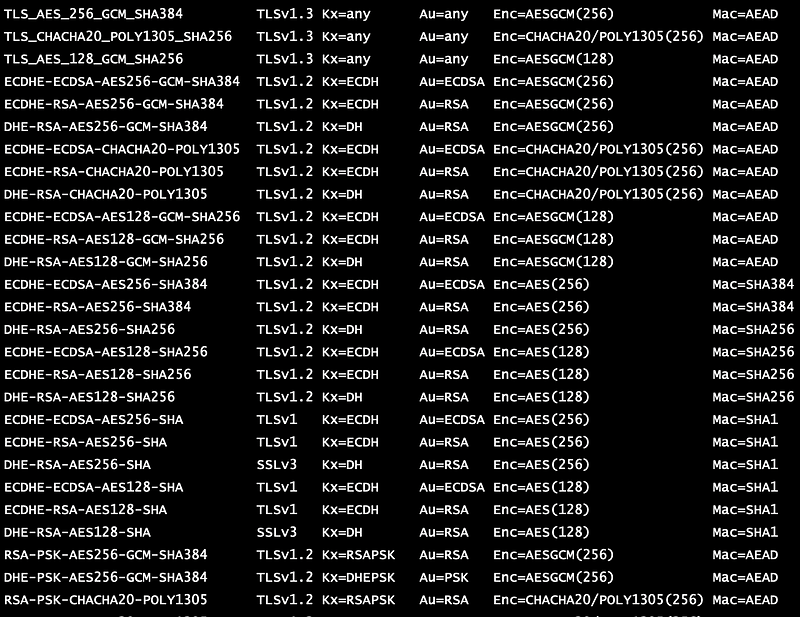What’s a Cipher Suite in TLS?

What’s a Cipher Suite in TLS?
Like it or not, our online privacy and trust is highly dependent on one little protocol: TLS (Transport Layer Security). Overall, TLS evolved from SSL (Secure Socket Layer), and is now at Version 1.3.
With TLS, we interrupt the network stack, and place it between the transport layer and the session layer. This creates an encryption tunnel between Bob and Alice, and where all of the data packets above the transport layer are encrypted. Initially, Bob and Alice determine the symmetric key that the data will be encrypted with. This is defined by the key exchange method (kex). The key that is then exchanged is then encrypted with a defined symmetric key (enc). The authentication of Alice to Bob is achieved from an authentication method (au) and each of the encrypted packets is then authenticated with a hashing method (mac).

Bob and Alice thus negotiate Enc, Au, Kx and a Mac. For this, Bob sends the methods that he wants to Alice in a client Hello, and Alice picks one of these and then the cipher suite is agreed. The format of the cipher suites is something like:
ECDHE-ECDSA-AES256-SHA In this case, we have ECDHE (Elliptic Curve Diffie Hellman) as the key exchange method, ECDSA (Elliptic Curve Digital Signature Algorithm) as the authentication method, 256-bit AES as the symmetric key method, and SHA-1 as the hashing method. Bob might then send:
ECDHE-ECDSA-AES256-SHA384
ECDHE-RSA-AES256-SHA384
DHE-RSA-AES256-SHA256
ECDHE-ECDSA-AES128-SHA256 and Alice will pick one of these for the secure tunnel. An outline is defined here:
Each version of TLS supports a range of protocols. For TLS 1.1, we have [here]:

You can list the full versions here:
https://asecuritysite.com/openssl/ciphers
With TLS 1.3, there are three suites: TLS_AES_256_GCM_SHA384, TLS_CHACHA20_POLY1305_SHA256 and TLS_AES_128_GCM_SHA256. These now support the stream cipher version of AES, and which are AES with GCM mode and ChaCha20/Poly 1305:
TLS_AES_256_GCM_SHA384 TLSv1.3 Kx=any Au=any Enc=AESGCM(256) Mac=AEAD
TLS_CHACHA20_POLY1305_SHA256 TLSv1.3 Kx=any Au=any Enc=CHACHA20/POLY1305(256) Mac=AEAD
TLS_AES_128_GCM_SHA256 TLSv1.3 Kx=any Au=any Enc=AESGCM(128) Mac=AEAD
ECDHE-ECDSA-AES256-GCM-SHA384 TLSv1.2 Kx=ECDH Au=ECDSA Enc=AESGCM(256) Mac=AEAD
ECDHE-RSA-AES256-GCM-SHA384 TLSv1.2 Kx=ECDH Au=RSA Enc=AESGCM(256) Mac=AEAD
DHE-RSA-AES256-GCM-SHA384 TLSv1.2 Kx=DH Au=RSA Enc=AESGCM(256) Mac=AEAD
ECDHE-ECDSA-CHACHA20-POLY1305 TLSv1.2 Kx=ECDH Au=ECDSA Enc=CHACHA20/POLY1305(256) Mac=AEAD
ECDHE-RSA-CHACHA20-POLY1305 TLSv1.2 Kx=ECDH Au=RSA Enc=CHACHA20/POLY1305(256) Mac=AEAD
DHE-RSA-CHACHA20-POLY1305 TLSv1.2 Kx=DH Au=RSA Enc=CHACHA20/POLY1305(256) Mac=AEAD
ECDHE-ECDSA-AES128-GCM-SHA256 TLSv1.2 Kx=ECDH Au=ECDSA Enc=AESGCM(128) Mac=AEAD
ECDHE-RSA-AES128-GCM-SHA256 TLSv1.2 Kx=ECDH Au=RSA Enc=AESGCM(128) Mac=AEAD
DHE-RSA-AES128-GCM-SHA256 TLSv1.2 Kx=DH Au=RSA Enc=AESGCM(128) Mac=AEAD
ECDHE-ECDSA-AES256-SHA384 TLSv1.2 Kx=ECDH Au=ECDSA Enc=AES(256) Mac=SHA384
ECDHE-RSA-AES256-SHA384 TLSv1.2 Kx=ECDH Au=RSA Enc=AES(256) Mac=SHA384
DHE-RSA-AES256-SHA256 TLSv1.2 Kx=DH Au=RSA Enc=AES(256) Mac=SHA256
ECDHE-ECDSA-AES128-SHA256 TLSv1.2 Kx=ECDH Au=ECDSA Enc=AES(128) Mac=SHA256
ECDHE-RSA-AES128-SHA256 TLSv1.2 Kx=ECDH Au=RSA Enc=AES(128) Mac=SHA256
DHE-RSA-AES128-SHA256 TLSv1.2 Kx=DH Au=RSA Enc=AES(128) Mac=SHA256
ECDHE-ECDSA-AES256-SHA TLSv1 Kx=ECDH Au=ECDSA Enc=AES(256) Mac=SHA1
ECDHE-RSA-AES256-SHA TLSv1 Kx=ECDH Au=RSA Enc=AES(256) Mac=SHA1
DHE-RSA-AES256-SHA SSLv3 Kx=DH Au=RSA Enc=AES(256) Mac=SHA1
ECDHE-ECDSA-AES128-SHA TLSv1 Kx=ECDH Au=ECDSA Enc=AES(128) Mac=SHA1
ECDHE-RSA-AES128-SHA TLSv1 Kx=ECDH Au=RSA Enc=AES(128) Mac=SHA1
DHE-RSA-AES128-SHA SSLv3 Kx=DH Au=RSA Enc=AES(128) Mac=SHA1
RSA-PSK-AES256-GCM-SHA384 TLSv1.2 Kx=RSAPSK Au=RSA Enc=AESGCM(256) Mac=AEAD
DHE-PSK-AES256-GCM-SHA384 TLSv1.2 Kx=DHEPSK Au=PSK Enc=AESGCM(256) Mac=AEAD
RSA-PSK-CHACHA20-POLY1305 TLSv1.2 Kx=RSAPSK Au=RSA Enc=CHACHA20/POLY1305(256) Mac=AEAD
DHE-PSK-CHACHA20-POLY1305 TLSv1.2 Kx=DHEPSK Au=PSK Enc=CHACHA20/POLY1305(256) Mac=AEAD
ECDHE-PSK-CHACHA20-POLY1305 TLSv1.2 Kx=ECDHEPSK Au=PSK Enc=CHACHA20/POLY1305(256) Mac=AEAD
AES256-GCM-SHA384 TLSv1.2 Kx=RSA Au=RSA Enc=AESGCM(256) Mac=AEAD
PSK-AES256-GCM-SHA384 TLSv1.2 Kx=PSK Au=PSK Enc=AESGCM(256) Mac=AEAD
PSK-CHACHA20-POLY1305 TLSv1.2 Kx=PSK Au=PSK Enc=CHACHA20/POLY1305(256) Mac=AEAD
RSA-PSK-AES128-GCM-SHA256 TLSv1.2 Kx=RSAPSK Au=RSA Enc=AESGCM(128) Mac=AEAD
DHE-PSK-AES128-GCM-SHA256 TLSv1.2 Kx=DHEPSK Au=PSK Enc=AESGCM(128) Mac=AEAD
AES128-GCM-SHA256 TLSv1.2 Kx=RSA Au=RSA Enc=AESGCM(128) Mac=AEAD
PSK-AES128-GCM-SHA256 TLSv1.2 Kx=PSK Au=PSK Enc=AESGCM(128) Mac=AEAD
AES256-SHA256 TLSv1.2 Kx=RSA Au=RSA Enc=AES(256) Mac=SHA256
AES128-SHA256 TLSv1.2 Kx=RSA Au=RSA Enc=AES(128) Mac=SHA256
ECDHE-PSK-AES256-CBC-SHA384 TLSv1 Kx=ECDHEPSK Au=PSK Enc=AES(256) Mac=SHA384
ECDHE-PSK-AES256-CBC-SHA TLSv1 Kx=ECDHEPSK Au=PSK Enc=AES(256) Mac=SHA1
SRP-RSA-AES-256-CBC-SHA SSLv3 Kx=SRP Au=RSA Enc=AES(256) Mac=SHA1
SRP-AES-256-CBC-SHA SSLv3 Kx=SRP Au=SRP Enc=AES(256) Mac=SHA1
RSA-PSK-AES256-CBC-SHA384 TLSv1 Kx=RSAPSK Au=RSA Enc=AES(256) Mac=SHA384
DHE-PSK-AES256-CBC-SHA384 TLSv1 Kx=DHEPSK Au=PSK Enc=AES(256) Mac=SHA384
RSA-PSK-AES256-CBC-SHA SSLv3 Kx=RSAPSK Au=RSA Enc=AES(256) Mac=SHA1
DHE-PSK-AES256-CBC-SHA SSLv3 Kx=DHEPSK Au=PSK Enc=AES(256) Mac=SHA1
AES256-SHA SSLv3 Kx=RSA Au=RSA Enc=AES(256) Mac=SHA1
PSK-AES256-CBC-SHA384 TLSv1 Kx=PSK Au=PSK Enc=AES(256) Mac=SHA384
PSK-AES256-CBC-SHA SSLv3 Kx=PSK Au=PSK Enc=AES(256) Mac=SHA1
ECDHE-PSK-AES128-CBC-SHA256 TLSv1 Kx=ECDHEPSK Au=PSK Enc=AES(128) Mac=SHA256
ECDHE-PSK-AES128-CBC-SHA TLSv1 Kx=ECDHEPSK Au=PSK Enc=AES(128) Mac=SHA1
SRP-RSA-AES-128-CBC-SHA SSLv3 Kx=SRP Au=RSA Enc=AES(128) Mac=SHA1
SRP-AES-128-CBC-SHA SSLv3 Kx=SRP Au=SRP Enc=AES(128) Mac=SHA1
RSA-PSK-AES128-CBC-SHA256 TLSv1 Kx=RSAPSK Au=RSA Enc=AES(128) Mac=SHA256
DHE-PSK-AES128-CBC-SHA256 TLSv1 Kx=DHEPSK Au=PSK Enc=AES(128) Mac=SHA256
RSA-PSK-AES128-CBC-SHA SSLv3 Kx=RSAPSK Au=RSA Enc=AES(128) Mac=SHA1
DHE-PSK-AES128-CBC-SHA SSLv3 Kx=DHEPSK Au=PSK Enc=AES(128) Mac=SHA1
AES128-SHA SSLv3 Kx=RSA Au=RSA Enc=AES(128) Mac=SHA1
PSK-AES128-CBC-SHA256 TLSv1 Kx=PSK Au=PSK Enc=AES(128) Mac=SHA256
PSK-AES128-CBC-SHA SSLv3 Kx=PSK Au=PSK Enc=AES(128) Mac=SHA1Conclusions
TLS is far from perfect — and where the tunnel can be broken — but it is better than nothing. So thank TLS for you not being spied upon, and for you not to connect to fake sites. And, it was actually Google who forced sites to support it.
Here is more on TLS: